BUS503 - Principles of Commercial Law: Negligence Report and Analysis
VerifiedAdded on 2022/12/19
|8
|2259
|40
Report
AI Summary
This report provides a comprehensive analysis of a negligence case, focusing on the key elements required to establish the tort of negligence. The report begins with an introduction that defines negligence and outlines the essential elements: duty of care, breach of duty, and causation of damage. It then delves into the specifics of establishing a duty of care, referencing the principles from the case of Donoghue v Stevenson and applying the Caparo test to the given scenario. The discussion examines the manager's responsibilities, including ensuring customer safety and addressing potential hazards. The report further explores the breach of duty, referencing relevant legislation and case law to determine whether the defendant met the required standard of care. The concept of a 'reasonable person' and the application of the Civil Liability Act are central to this section. Finally, the report addresses causation of damage, including the 'but for' test, and considers the defenses available to the defendant, such as voluntary assumption of risk and contributory negligence. The report concludes by summarizing the potential outcomes of the case, including possible claims for damages and the role of the defendant's actions in causing the plaintiff's injuries.
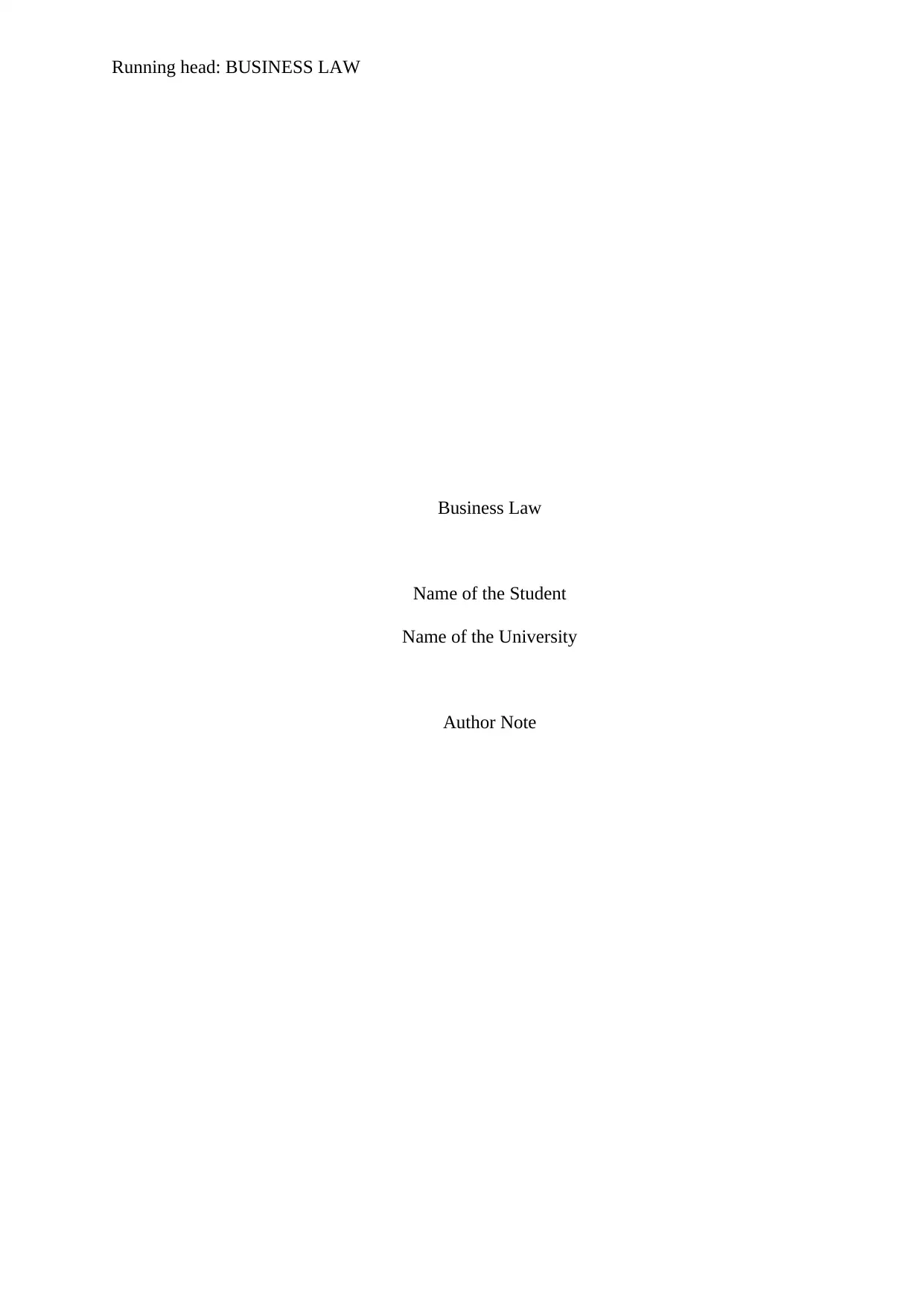
Running head: BUSINESS LAW
Business Law
Name of the Student
Name of the University
Author Note
Business Law
Name of the Student
Name of the University
Author Note
Paraphrase This Document
Need a fresh take? Get an instant paraphrase of this document with our AI Paraphraser
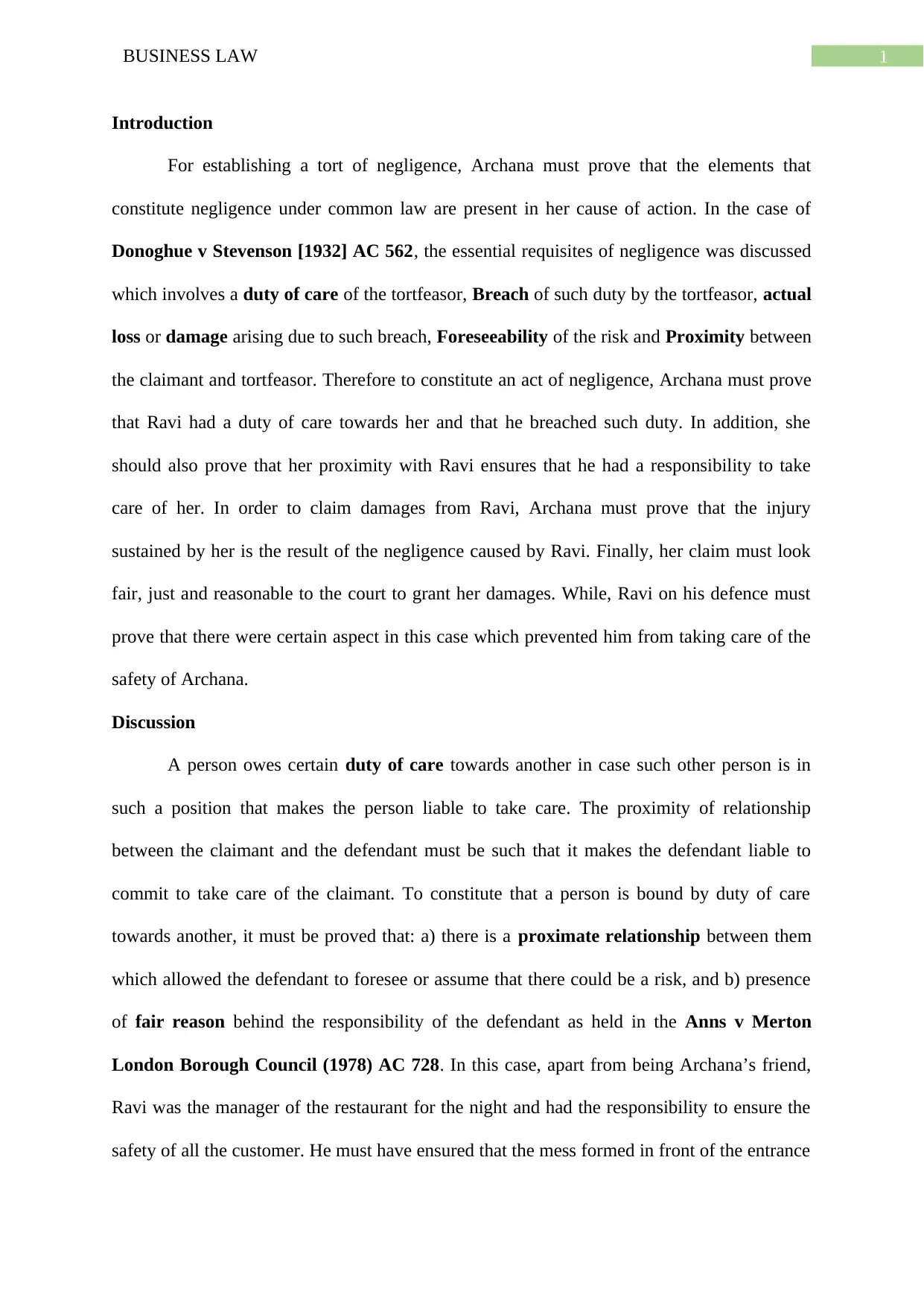
1BUSINESS LAW
Introduction
For establishing a tort of negligence, Archana must prove that the elements that
constitute negligence under common law are present in her cause of action. In the case of
Donoghue v Stevenson [1932] AC 562, the essential requisites of negligence was discussed
which involves a duty of care of the tortfeasor, Breach of such duty by the tortfeasor, actual
loss or damage arising due to such breach, Foreseeability of the risk and Proximity between
the claimant and tortfeasor. Therefore to constitute an act of negligence, Archana must prove
that Ravi had a duty of care towards her and that he breached such duty. In addition, she
should also prove that her proximity with Ravi ensures that he had a responsibility to take
care of her. In order to claim damages from Ravi, Archana must prove that the injury
sustained by her is the result of the negligence caused by Ravi. Finally, her claim must look
fair, just and reasonable to the court to grant her damages. While, Ravi on his defence must
prove that there were certain aspect in this case which prevented him from taking care of the
safety of Archana.
Discussion
A person owes certain duty of care towards another in case such other person is in
such a position that makes the person liable to take care. The proximity of relationship
between the claimant and the defendant must be such that it makes the defendant liable to
commit to take care of the claimant. To constitute that a person is bound by duty of care
towards another, it must be proved that: a) there is a proximate relationship between them
which allowed the defendant to foresee or assume that there could be a risk, and b) presence
of fair reason behind the responsibility of the defendant as held in the Anns v Merton
London Borough Council (1978) AC 728. In this case, apart from being Archana’s friend,
Ravi was the manager of the restaurant for the night and had the responsibility to ensure the
safety of all the customer. He must have ensured that the mess formed in front of the entrance
Introduction
For establishing a tort of negligence, Archana must prove that the elements that
constitute negligence under common law are present in her cause of action. In the case of
Donoghue v Stevenson [1932] AC 562, the essential requisites of negligence was discussed
which involves a duty of care of the tortfeasor, Breach of such duty by the tortfeasor, actual
loss or damage arising due to such breach, Foreseeability of the risk and Proximity between
the claimant and tortfeasor. Therefore to constitute an act of negligence, Archana must prove
that Ravi had a duty of care towards her and that he breached such duty. In addition, she
should also prove that her proximity with Ravi ensures that he had a responsibility to take
care of her. In order to claim damages from Ravi, Archana must prove that the injury
sustained by her is the result of the negligence caused by Ravi. Finally, her claim must look
fair, just and reasonable to the court to grant her damages. While, Ravi on his defence must
prove that there were certain aspect in this case which prevented him from taking care of the
safety of Archana.
Discussion
A person owes certain duty of care towards another in case such other person is in
such a position that makes the person liable to take care. The proximity of relationship
between the claimant and the defendant must be such that it makes the defendant liable to
commit to take care of the claimant. To constitute that a person is bound by duty of care
towards another, it must be proved that: a) there is a proximate relationship between them
which allowed the defendant to foresee or assume that there could be a risk, and b) presence
of fair reason behind the responsibility of the defendant as held in the Anns v Merton
London Borough Council (1978) AC 728. In this case, apart from being Archana’s friend,
Ravi was the manager of the restaurant for the night and had the responsibility to ensure the
safety of all the customer. He must have ensured that the mess formed in front of the entrance
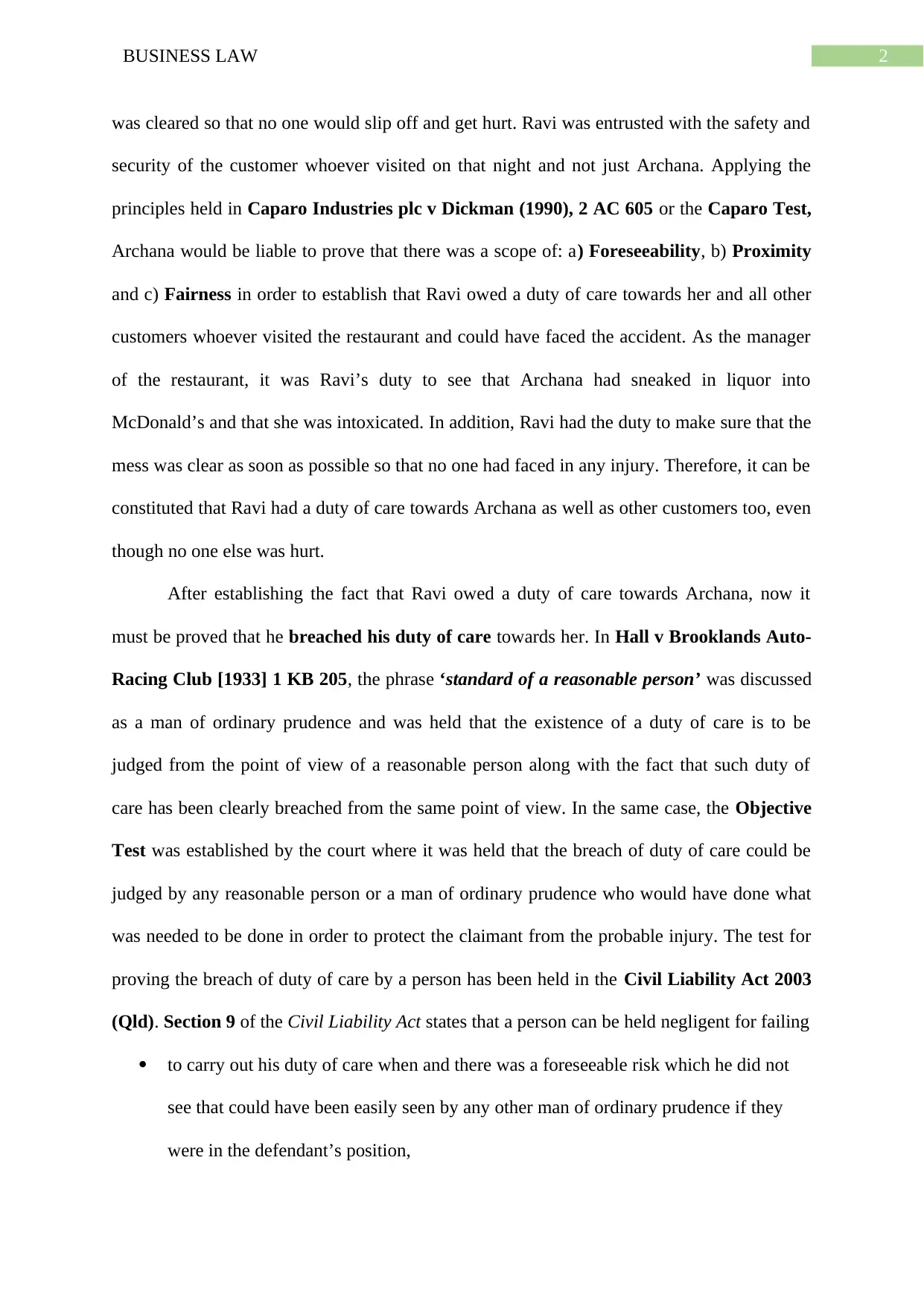
2BUSINESS LAW
was cleared so that no one would slip off and get hurt. Ravi was entrusted with the safety and
security of the customer whoever visited on that night and not just Archana. Applying the
principles held in Caparo Industries plc v Dickman (1990), 2 AC 605 or the Caparo Test,
Archana would be liable to prove that there was a scope of: a) Foreseeability, b) Proximity
and c) Fairness in order to establish that Ravi owed a duty of care towards her and all other
customers whoever visited the restaurant and could have faced the accident. As the manager
of the restaurant, it was Ravi’s duty to see that Archana had sneaked in liquor into
McDonald’s and that she was intoxicated. In addition, Ravi had the duty to make sure that the
mess was clear as soon as possible so that no one had faced in any injury. Therefore, it can be
constituted that Ravi had a duty of care towards Archana as well as other customers too, even
though no one else was hurt.
After establishing the fact that Ravi owed a duty of care towards Archana, now it
must be proved that he breached his duty of care towards her. In Hall v Brooklands Auto-
Racing Club [1933] 1 KB 205, the phrase ‘standard of a reasonable person’ was discussed
as a man of ordinary prudence and was held that the existence of a duty of care is to be
judged from the point of view of a reasonable person along with the fact that such duty of
care has been clearly breached from the same point of view. In the same case, the Objective
Test was established by the court where it was held that the breach of duty of care could be
judged by any reasonable person or a man of ordinary prudence who would have done what
was needed to be done in order to protect the claimant from the probable injury. The test for
proving the breach of duty of care by a person has been held in the Civil Liability Act 2003
(Qld). Section 9 of the Civil Liability Act states that a person can be held negligent for failing
to carry out his duty of care when and there was a foreseeable risk which he did not
see that could have been easily seen by any other man of ordinary prudence if they
were in the defendant’s position,
was cleared so that no one would slip off and get hurt. Ravi was entrusted with the safety and
security of the customer whoever visited on that night and not just Archana. Applying the
principles held in Caparo Industries plc v Dickman (1990), 2 AC 605 or the Caparo Test,
Archana would be liable to prove that there was a scope of: a) Foreseeability, b) Proximity
and c) Fairness in order to establish that Ravi owed a duty of care towards her and all other
customers whoever visited the restaurant and could have faced the accident. As the manager
of the restaurant, it was Ravi’s duty to see that Archana had sneaked in liquor into
McDonald’s and that she was intoxicated. In addition, Ravi had the duty to make sure that the
mess was clear as soon as possible so that no one had faced in any injury. Therefore, it can be
constituted that Ravi had a duty of care towards Archana as well as other customers too, even
though no one else was hurt.
After establishing the fact that Ravi owed a duty of care towards Archana, now it
must be proved that he breached his duty of care towards her. In Hall v Brooklands Auto-
Racing Club [1933] 1 KB 205, the phrase ‘standard of a reasonable person’ was discussed
as a man of ordinary prudence and was held that the existence of a duty of care is to be
judged from the point of view of a reasonable person along with the fact that such duty of
care has been clearly breached from the same point of view. In the same case, the Objective
Test was established by the court where it was held that the breach of duty of care could be
judged by any reasonable person or a man of ordinary prudence who would have done what
was needed to be done in order to protect the claimant from the probable injury. The test for
proving the breach of duty of care by a person has been held in the Civil Liability Act 2003
(Qld). Section 9 of the Civil Liability Act states that a person can be held negligent for failing
to carry out his duty of care when and there was a foreseeable risk which he did not
see that could have been easily seen by any other man of ordinary prudence if they
were in the defendant’s position,
⊘ This is a preview!⊘
Do you want full access?
Subscribe today to unlock all pages.

Trusted by 1+ million students worldwide
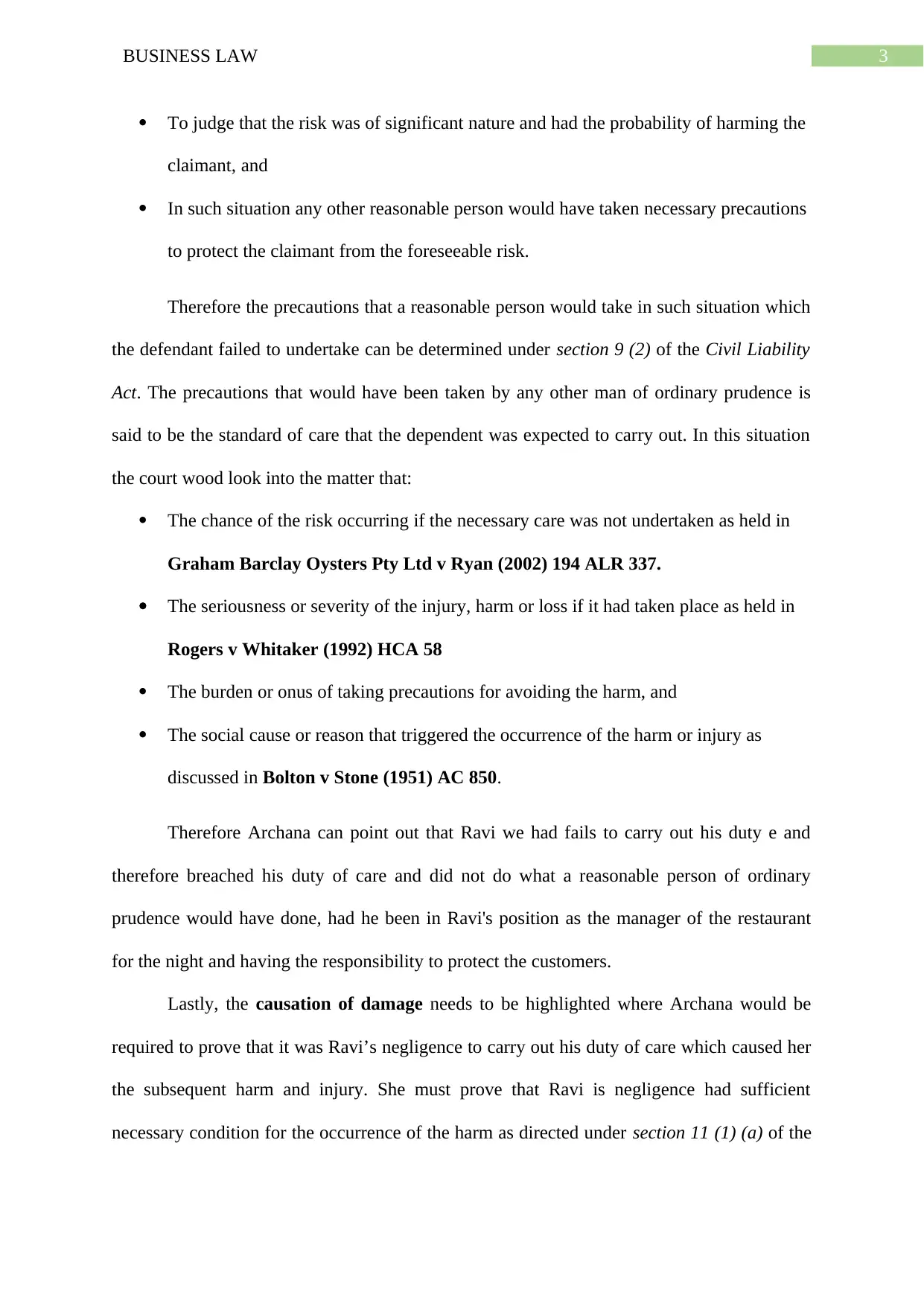
3BUSINESS LAW
To judge that the risk was of significant nature and had the probability of harming the
claimant, and
In such situation any other reasonable person would have taken necessary precautions
to protect the claimant from the foreseeable risk.
Therefore the precautions that a reasonable person would take in such situation which
the defendant failed to undertake can be determined under section 9 (2) of the Civil Liability
Act. The precautions that would have been taken by any other man of ordinary prudence is
said to be the standard of care that the dependent was expected to carry out. In this situation
the court wood look into the matter that:
The chance of the risk occurring if the necessary care was not undertaken as held in
Graham Barclay Oysters Pty Ltd v Ryan (2002) 194 ALR 337.
The seriousness or severity of the injury, harm or loss if it had taken place as held in
Rogers v Whitaker (1992) HCA 58
The burden or onus of taking precautions for avoiding the harm, and
The social cause or reason that triggered the occurrence of the harm or injury as
discussed in Bolton v Stone (1951) AC 850.
Therefore Archana can point out that Ravi we had fails to carry out his duty e and
therefore breached his duty of care and did not do what a reasonable person of ordinary
prudence would have done, had he been in Ravi's position as the manager of the restaurant
for the night and having the responsibility to protect the customers.
Lastly, the causation of damage needs to be highlighted where Archana would be
required to prove that it was Ravi’s negligence to carry out his duty of care which caused her
the subsequent harm and injury. She must prove that Ravi is negligence had sufficient
necessary condition for the occurrence of the harm as directed under section 11 (1) (a) of the
To judge that the risk was of significant nature and had the probability of harming the
claimant, and
In such situation any other reasonable person would have taken necessary precautions
to protect the claimant from the foreseeable risk.
Therefore the precautions that a reasonable person would take in such situation which
the defendant failed to undertake can be determined under section 9 (2) of the Civil Liability
Act. The precautions that would have been taken by any other man of ordinary prudence is
said to be the standard of care that the dependent was expected to carry out. In this situation
the court wood look into the matter that:
The chance of the risk occurring if the necessary care was not undertaken as held in
Graham Barclay Oysters Pty Ltd v Ryan (2002) 194 ALR 337.
The seriousness or severity of the injury, harm or loss if it had taken place as held in
Rogers v Whitaker (1992) HCA 58
The burden or onus of taking precautions for avoiding the harm, and
The social cause or reason that triggered the occurrence of the harm or injury as
discussed in Bolton v Stone (1951) AC 850.
Therefore Archana can point out that Ravi we had fails to carry out his duty e and
therefore breached his duty of care and did not do what a reasonable person of ordinary
prudence would have done, had he been in Ravi's position as the manager of the restaurant
for the night and having the responsibility to protect the customers.
Lastly, the causation of damage needs to be highlighted where Archana would be
required to prove that it was Ravi’s negligence to carry out his duty of care which caused her
the subsequent harm and injury. She must prove that Ravi is negligence had sufficient
necessary condition for the occurrence of the harm as directed under section 11 (1) (a) of the
Paraphrase This Document
Need a fresh take? Get an instant paraphrase of this document with our AI Paraphraser
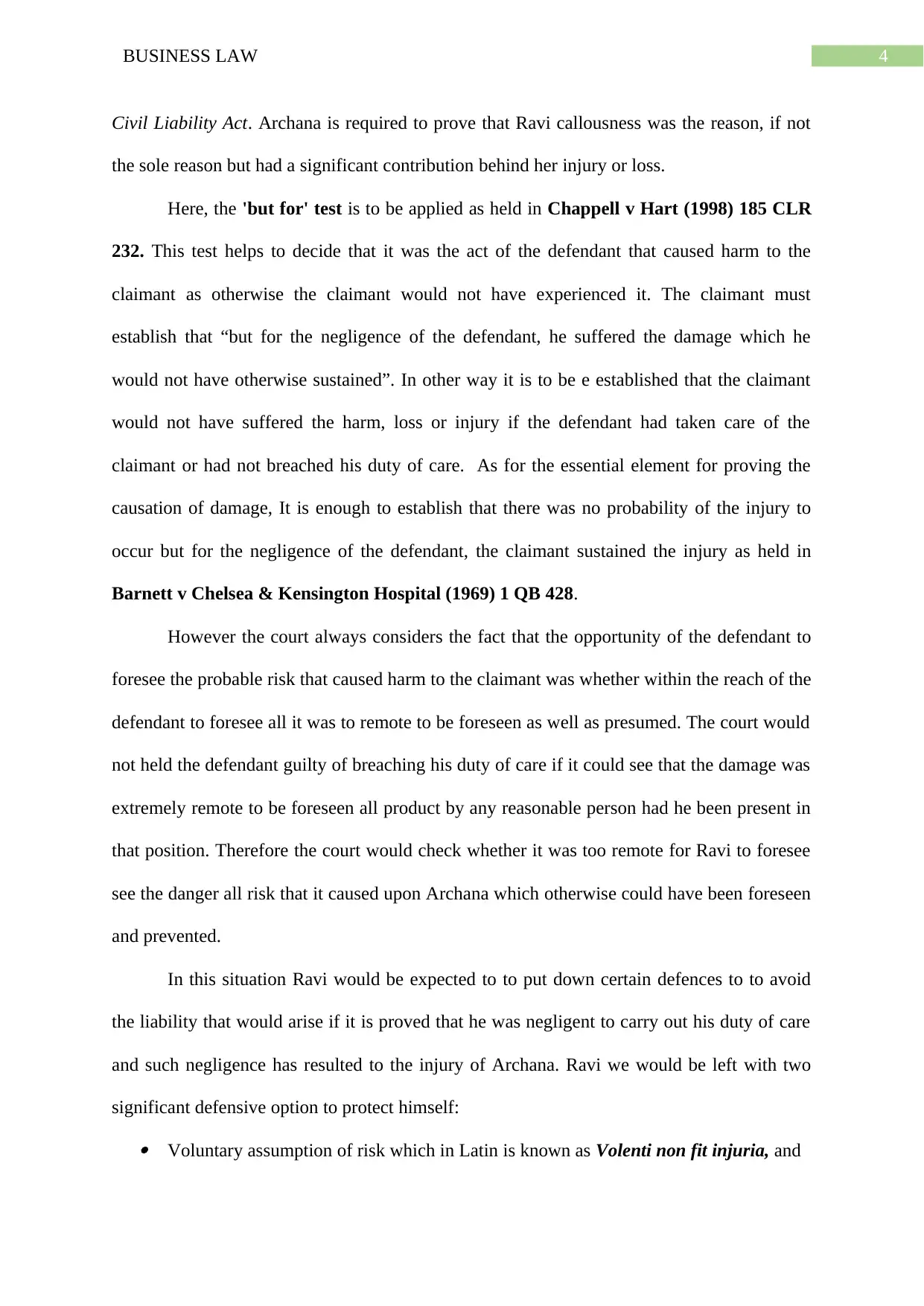
4BUSINESS LAW
Civil Liability Act. Archana is required to prove that Ravi callousness was the reason, if not
the sole reason but had a significant contribution behind her injury or loss.
Here, the 'but for' test is to be applied as held in Chappell v Hart (1998) 185 CLR
232. This test helps to decide that it was the act of the defendant that caused harm to the
claimant as otherwise the claimant would not have experienced it. The claimant must
establish that “but for the negligence of the defendant, he suffered the damage which he
would not have otherwise sustained”. In other way it is to be e established that the claimant
would not have suffered the harm, loss or injury if the defendant had taken care of the
claimant or had not breached his duty of care. As for the essential element for proving the
causation of damage, It is enough to establish that there was no probability of the injury to
occur but for the negligence of the defendant, the claimant sustained the injury as held in
Barnett v Chelsea & Kensington Hospital (1969) 1 QB 428.
However the court always considers the fact that the opportunity of the defendant to
foresee the probable risk that caused harm to the claimant was whether within the reach of the
defendant to foresee all it was to remote to be foreseen as well as presumed. The court would
not held the defendant guilty of breaching his duty of care if it could see that the damage was
extremely remote to be foreseen all product by any reasonable person had he been present in
that position. Therefore the court would check whether it was too remote for Ravi to foresee
see the danger all risk that it caused upon Archana which otherwise could have been foreseen
and prevented.
In this situation Ravi would be expected to to put down certain defences to to avoid
the liability that would arise if it is proved that he was negligent to carry out his duty of care
and such negligence has resulted to the injury of Archana. Ravi we would be left with two
significant defensive option to protect himself: Voluntary assumption of risk which in Latin is known as Volenti non fit injuria, and
Civil Liability Act. Archana is required to prove that Ravi callousness was the reason, if not
the sole reason but had a significant contribution behind her injury or loss.
Here, the 'but for' test is to be applied as held in Chappell v Hart (1998) 185 CLR
232. This test helps to decide that it was the act of the defendant that caused harm to the
claimant as otherwise the claimant would not have experienced it. The claimant must
establish that “but for the negligence of the defendant, he suffered the damage which he
would not have otherwise sustained”. In other way it is to be e established that the claimant
would not have suffered the harm, loss or injury if the defendant had taken care of the
claimant or had not breached his duty of care. As for the essential element for proving the
causation of damage, It is enough to establish that there was no probability of the injury to
occur but for the negligence of the defendant, the claimant sustained the injury as held in
Barnett v Chelsea & Kensington Hospital (1969) 1 QB 428.
However the court always considers the fact that the opportunity of the defendant to
foresee the probable risk that caused harm to the claimant was whether within the reach of the
defendant to foresee all it was to remote to be foreseen as well as presumed. The court would
not held the defendant guilty of breaching his duty of care if it could see that the damage was
extremely remote to be foreseen all product by any reasonable person had he been present in
that position. Therefore the court would check whether it was too remote for Ravi to foresee
see the danger all risk that it caused upon Archana which otherwise could have been foreseen
and prevented.
In this situation Ravi would be expected to to put down certain defences to to avoid
the liability that would arise if it is proved that he was negligent to carry out his duty of care
and such negligence has resulted to the injury of Archana. Ravi we would be left with two
significant defensive option to protect himself: Voluntary assumption of risk which in Latin is known as Volenti non fit injuria, and
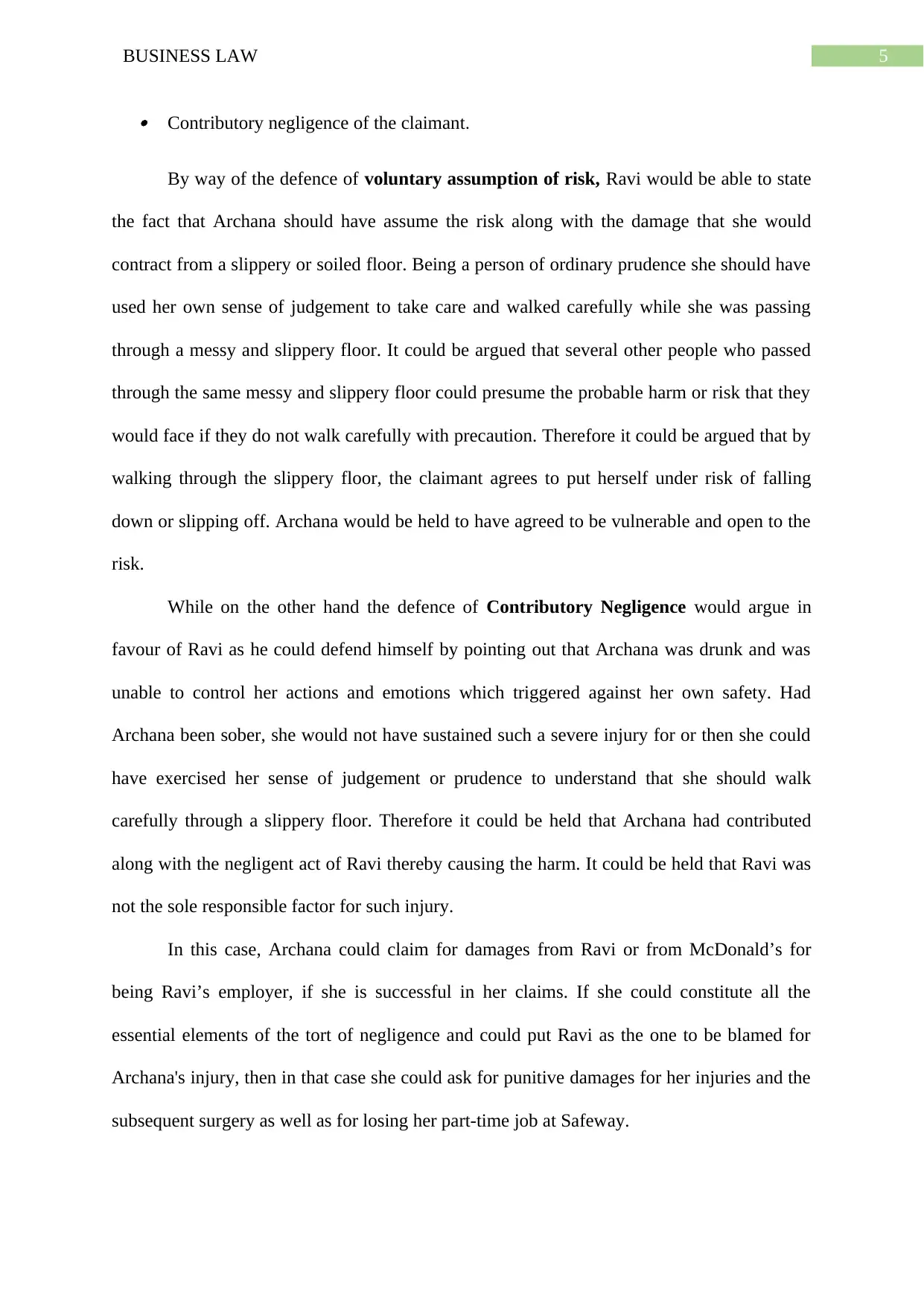
5BUSINESS LAW
Contributory negligence of the claimant.
By way of the defence of voluntary assumption of risk, Ravi would be able to state
the fact that Archana should have assume the risk along with the damage that she would
contract from a slippery or soiled floor. Being a person of ordinary prudence she should have
used her own sense of judgement to take care and walked carefully while she was passing
through a messy and slippery floor. It could be argued that several other people who passed
through the same messy and slippery floor could presume the probable harm or risk that they
would face if they do not walk carefully with precaution. Therefore it could be argued that by
walking through the slippery floor, the claimant agrees to put herself under risk of falling
down or slipping off. Archana would be held to have agreed to be vulnerable and open to the
risk.
While on the other hand the defence of Contributory Negligence would argue in
favour of Ravi as he could defend himself by pointing out that Archana was drunk and was
unable to control her actions and emotions which triggered against her own safety. Had
Archana been sober, she would not have sustained such a severe injury for or then she could
have exercised her sense of judgement or prudence to understand that she should walk
carefully through a slippery floor. Therefore it could be held that Archana had contributed
along with the negligent act of Ravi thereby causing the harm. It could be held that Ravi was
not the sole responsible factor for such injury.
In this case, Archana could claim for damages from Ravi or from McDonald’s for
being Ravi’s employer, if she is successful in her claims. If she could constitute all the
essential elements of the tort of negligence and could put Ravi as the one to be blamed for
Archana's injury, then in that case she could ask for punitive damages for her injuries and the
subsequent surgery as well as for losing her part-time job at Safeway.
Contributory negligence of the claimant.
By way of the defence of voluntary assumption of risk, Ravi would be able to state
the fact that Archana should have assume the risk along with the damage that she would
contract from a slippery or soiled floor. Being a person of ordinary prudence she should have
used her own sense of judgement to take care and walked carefully while she was passing
through a messy and slippery floor. It could be argued that several other people who passed
through the same messy and slippery floor could presume the probable harm or risk that they
would face if they do not walk carefully with precaution. Therefore it could be argued that by
walking through the slippery floor, the claimant agrees to put herself under risk of falling
down or slipping off. Archana would be held to have agreed to be vulnerable and open to the
risk.
While on the other hand the defence of Contributory Negligence would argue in
favour of Ravi as he could defend himself by pointing out that Archana was drunk and was
unable to control her actions and emotions which triggered against her own safety. Had
Archana been sober, she would not have sustained such a severe injury for or then she could
have exercised her sense of judgement or prudence to understand that she should walk
carefully through a slippery floor. Therefore it could be held that Archana had contributed
along with the negligent act of Ravi thereby causing the harm. It could be held that Ravi was
not the sole responsible factor for such injury.
In this case, Archana could claim for damages from Ravi or from McDonald’s for
being Ravi’s employer, if she is successful in her claims. If she could constitute all the
essential elements of the tort of negligence and could put Ravi as the one to be blamed for
Archana's injury, then in that case she could ask for punitive damages for her injuries and the
subsequent surgery as well as for losing her part-time job at Safeway.
⊘ This is a preview!⊘
Do you want full access?
Subscribe today to unlock all pages.

Trusted by 1+ million students worldwide
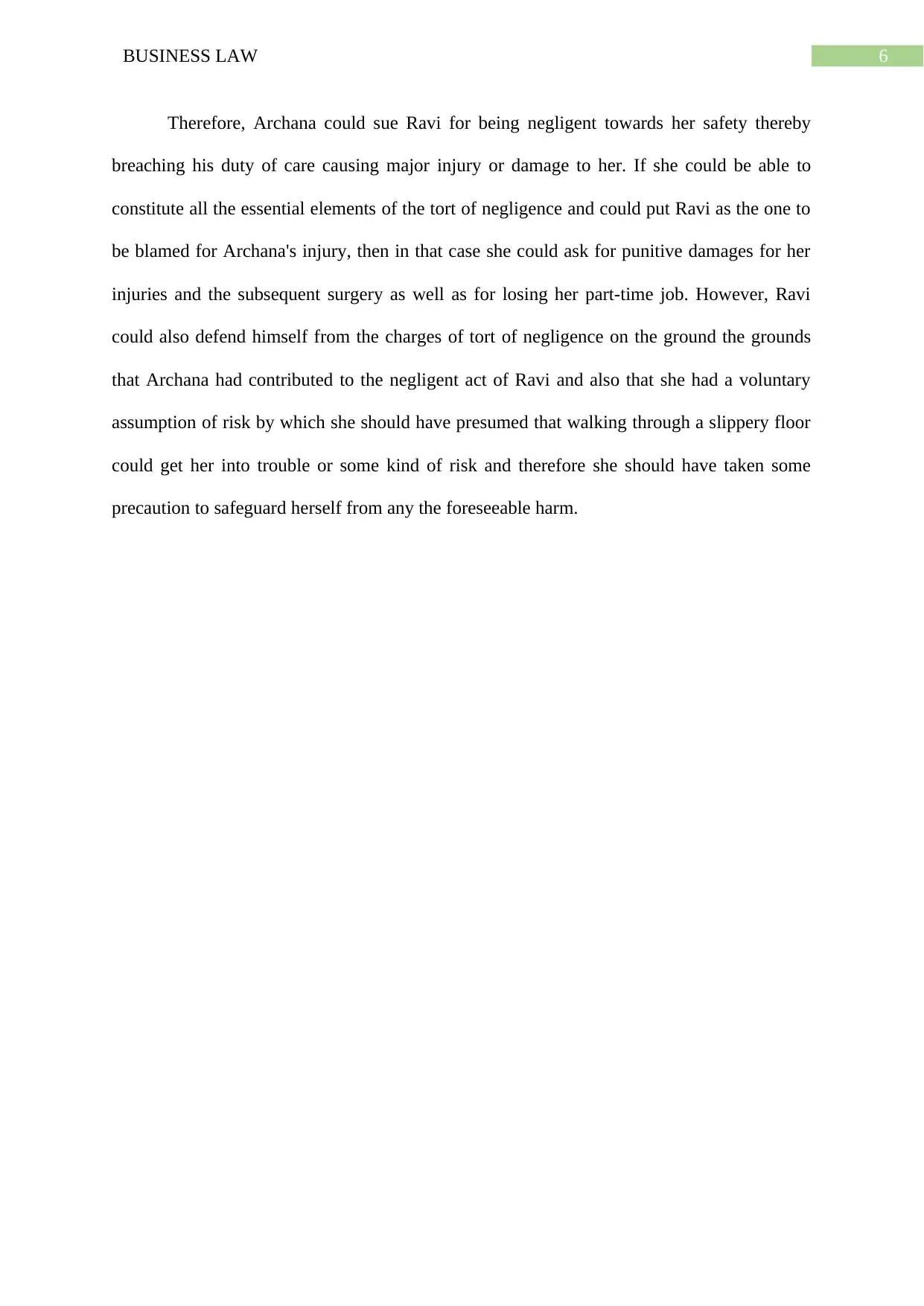
6BUSINESS LAW
Therefore, Archana could sue Ravi for being negligent towards her safety thereby
breaching his duty of care causing major injury or damage to her. If she could be able to
constitute all the essential elements of the tort of negligence and could put Ravi as the one to
be blamed for Archana's injury, then in that case she could ask for punitive damages for her
injuries and the subsequent surgery as well as for losing her part-time job. However, Ravi
could also defend himself from the charges of tort of negligence on the ground the grounds
that Archana had contributed to the negligent act of Ravi and also that she had a voluntary
assumption of risk by which she should have presumed that walking through a slippery floor
could get her into trouble or some kind of risk and therefore she should have taken some
precaution to safeguard herself from any the foreseeable harm.
Therefore, Archana could sue Ravi for being negligent towards her safety thereby
breaching his duty of care causing major injury or damage to her. If she could be able to
constitute all the essential elements of the tort of negligence and could put Ravi as the one to
be blamed for Archana's injury, then in that case she could ask for punitive damages for her
injuries and the subsequent surgery as well as for losing her part-time job. However, Ravi
could also defend himself from the charges of tort of negligence on the ground the grounds
that Archana had contributed to the negligent act of Ravi and also that she had a voluntary
assumption of risk by which she should have presumed that walking through a slippery floor
could get her into trouble or some kind of risk and therefore she should have taken some
precaution to safeguard herself from any the foreseeable harm.
Paraphrase This Document
Need a fresh take? Get an instant paraphrase of this document with our AI Paraphraser
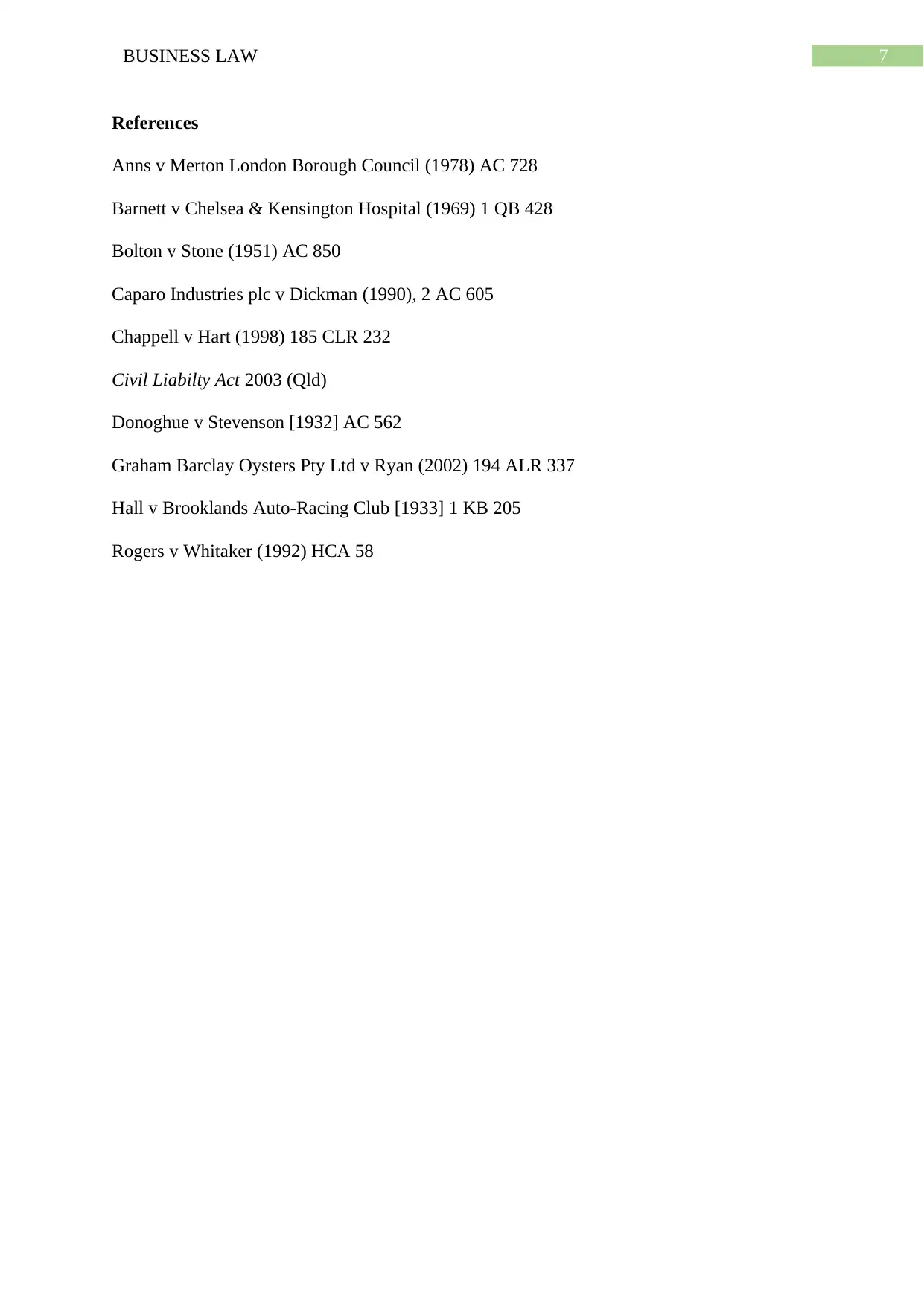
7BUSINESS LAW
References
Anns v Merton London Borough Council (1978) AC 728
Barnett v Chelsea & Kensington Hospital (1969) 1 QB 428
Bolton v Stone (1951) AC 850
Caparo Industries plc v Dickman (1990), 2 AC 605
Chappell v Hart (1998) 185 CLR 232
Civil Liabilty Act 2003 (Qld)
Donoghue v Stevenson [1932] AC 562
Graham Barclay Oysters Pty Ltd v Ryan (2002) 194 ALR 337
Hall v Brooklands Auto-Racing Club [1933] 1 KB 205
Rogers v Whitaker (1992) HCA 58
References
Anns v Merton London Borough Council (1978) AC 728
Barnett v Chelsea & Kensington Hospital (1969) 1 QB 428
Bolton v Stone (1951) AC 850
Caparo Industries plc v Dickman (1990), 2 AC 605
Chappell v Hart (1998) 185 CLR 232
Civil Liabilty Act 2003 (Qld)
Donoghue v Stevenson [1932] AC 562
Graham Barclay Oysters Pty Ltd v Ryan (2002) 194 ALR 337
Hall v Brooklands Auto-Racing Club [1933] 1 KB 205
Rogers v Whitaker (1992) HCA 58
1 out of 8
Related Documents
Your All-in-One AI-Powered Toolkit for Academic Success.
+13062052269
info@desklib.com
Available 24*7 on WhatsApp / Email
![[object Object]](/_next/static/media/star-bottom.7253800d.svg)
Unlock your academic potential
Copyright © 2020–2025 A2Z Services. All Rights Reserved. Developed and managed by ZUCOL.





